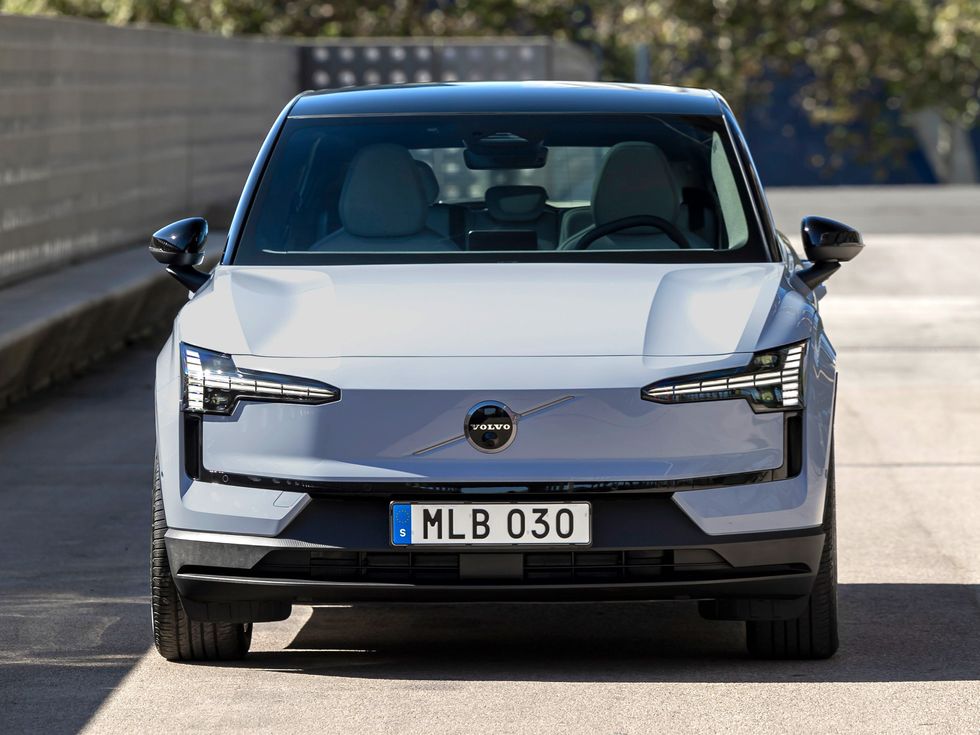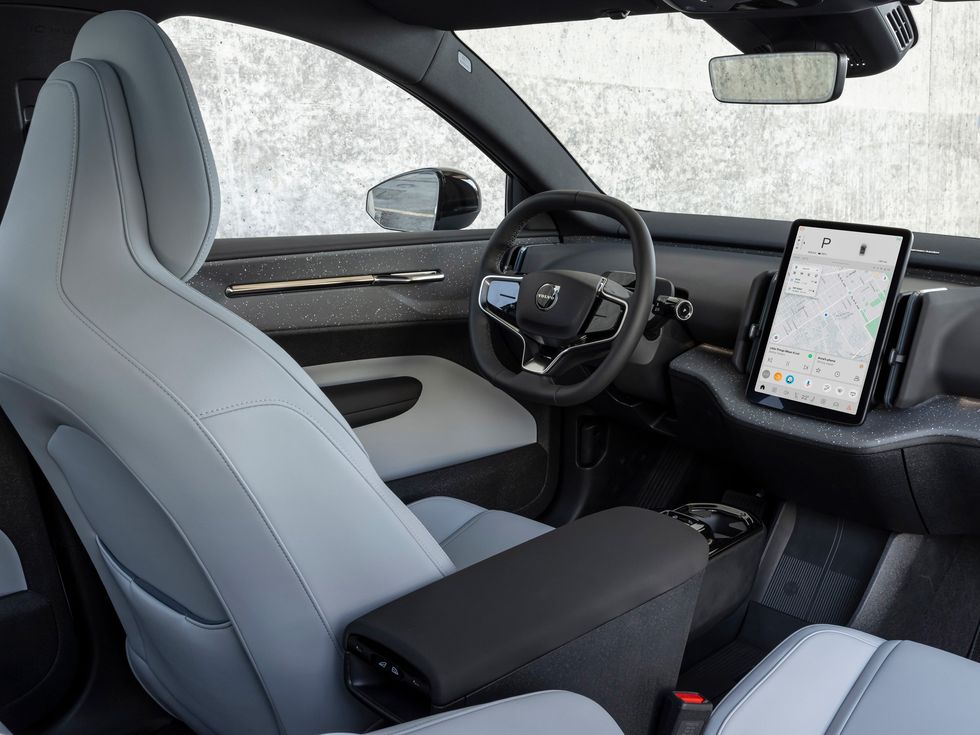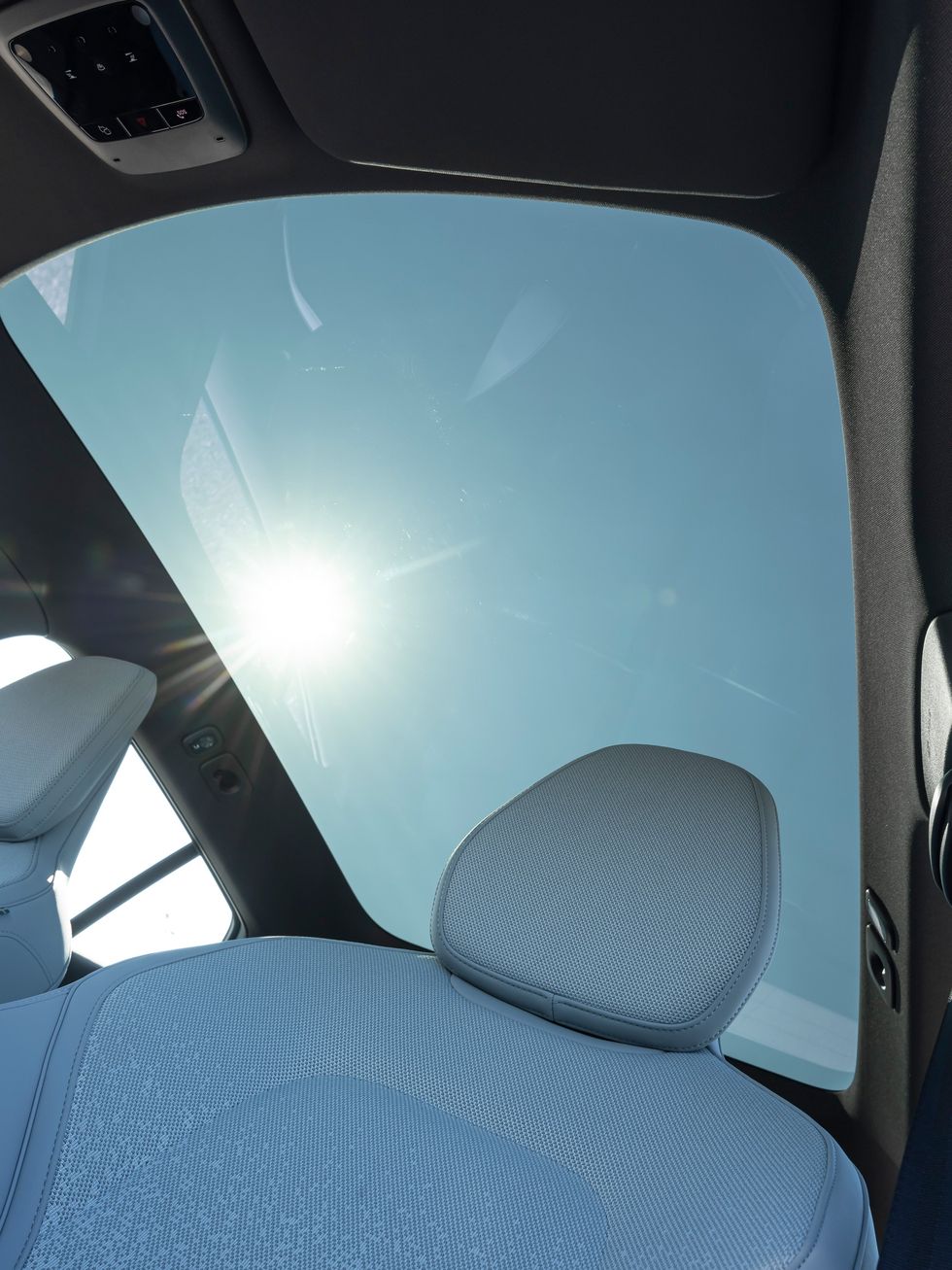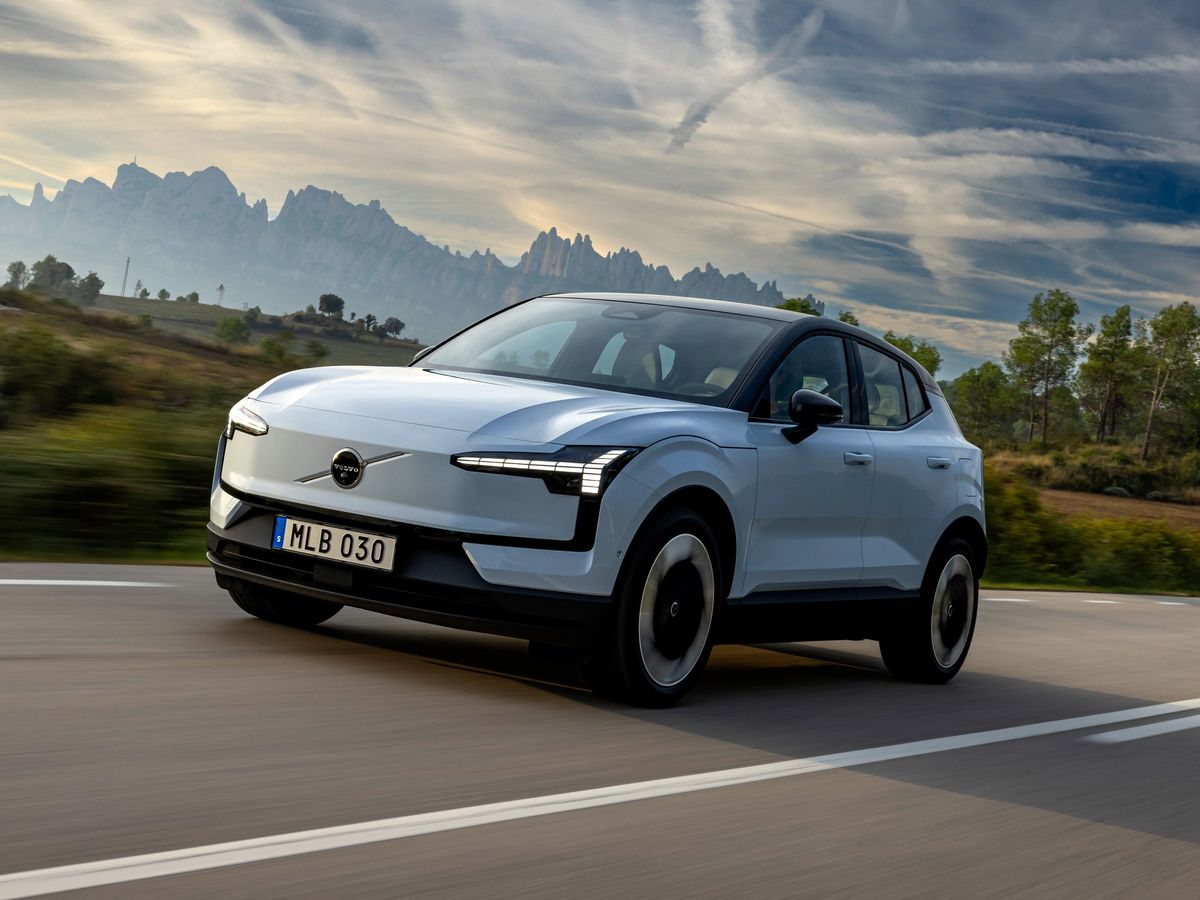For such a tiny and intensely powerful EV—an “espresso shot” of Volvo, according to its maker—the new EX30 carries big hopes but plenty of baggage.
The EX30 brings the hallmarks of larger Volvos: squeaky-clean Scandinavian design, a canny blend of comfort and performance, and an obsessive focus on safety. But the EX30 is made in China, at a Zhangjiakou factory that will also build its electric stablemates, the Zeekr X and Smart #1. Geely Auto owns those Chinese-market brands, in addition to majority stakes in Volvo and Lotus. And while the Volvo badge says “Sweden,” the EX30’s birthplace puts a target on its back in the United States.
The Biden administration’s Inflation Reduction Act (IRA) aims to spur homegrown EV factories and a battery supply chain through the carrot of consumer and manufacturer incentives. The proudly protectionist IRA carries an equally big stick, denying subsidies to anything with a whiff of Chinese (or Russian) provenance, in an effort to stem China’s global dominance over batteries and mineral refining.
That makes the EX30 both a stalking horse—and potential Trojan horse—for affordable Chinese-built automobiles in North America and Europe alike. The Volvo’s base price of U.S. $36,245 (including a $1,295 destination charge) flat-out kneecaps the prices of comparable EVs in North America and Europe. It costs about $7,000 less than Tesla’s most-affordable Model 3 sedan, and nearly $20,000 less than the larger Model Y SUV, despite Tesla’s ruthless price cuts, which have left Ford and other rivals reeling. That all highlights China’s sobering EV advantages, including labor prices that Detroit’s Biden-backed union factories can’t touch. That was before the United Auto Workers went on strike to demand a (surely forthcoming) major hike in wages, and assurances of future job security in a tumultuous transition from internal-combustion-engine (ICE) technology to EVs. And with Volvo helping Geely raise its international game, including styling the Zeekr X from its design center in Gothenburg, Sweden, Zeekr hopes to enter the European market itself in 2024. This EX30 may be small on the outside, but it carries outsize impact and a potential provocation to Western automakers and governments.
Some industry analysts suggest Geely and Volvo will take a financial loss on the EX30 to help establish an electric foothold outside of China. Volvo executives insist the car is designed to turn a profit. Skepticism over that claim is bolstered by Volvo having to pay a stiff 27.5 percent tariff on every EX30 it imports to the United States from China. Either way, the price remains a tempting $36,245 to start. Lease the Volvo and get a $7,500 consumer tax credit (more on the “leasing loophole” later), and you’re looking at $28,745, about $20,000 less than the price of the average new car. If the prospect of a low monthly payment washes away any geopolitical or personal concerns, Volvo is taking orders as we speak.
Driving the Volvo EX30
I tried to set political machinations aside during a pleasant two days with the EX30 in Catalan, Spain. Setting off from Barcelona, it was easy to take the Volvo at face value: An adorably styled crossover that does a masterful job of disguising just how small it is, and how it was designed to that ultra-affordable price point. Slicing through Barcelona traffic, surrounded by buzzing scooters and tiny cars, the Volvo felt right at home. But compared to penny-pinching European subcompacts, the Volvo is a serious cut above in design and sophisticated performance.
“It’s a small SUV doing Volvo things,” is how Jim Rowan, the automaker’s Scottish-born CEO, described it.

“Volvo things” definitely describes the design, as much a tall hatchback as any “SUV.” The EX30 takes cues from its handsome big brother, the XC40 Recharge. A cheek-pinching robotic face— with no traditional grille required for ICE systems cooling—is lit by the brand’s familiar “Thor’s Hammer” LED headlamps. Scalloped body sides and a jaunty descending roofline amplify the appealing style. Standard 19-inch wheels with wind-cheating aero blades and energy-saving tires are another luxury touch. Twin-motor models boost the wheels to a brawny 20-inches.
Only the interior—with some hard, hollow-feeling plastics in lower regions—offers clues that the China-built Volvo had bean counters to answer to. Yet it’s still a comfortable, inviting space. Volvo ably covers this SUV’s plebeian roots with a grippy, squared-off steering wheel and the brand’s sculpted, safety-enhancing seats. A space-saving center console features clever cupholders that extend singly or in a pair. There’s generous storage below the cantilevered armrest, and a pull-out tray for rear passengers. Sustainable materials abound. Textile mats are made from recycled fishing nets, carpeting from PET bottles, and a woven “Flex Deco” dashboard material from flax. Available seat coverings include a tailored blend of wool and recycled polyester. A clever Harman/Kardon soundbar spans the entire dash below the windshield, eliminating the need for door speakers. Most EX30 models integrate a cabin heat pump to conserve energy.
Adopting Tesla’s reductionist approach, virtually all controls and readouts are housed in a tablet-shaped center screen, including some, such as a speedometer, audio level, and exterior mirrors, that would be better served with traditional analog switches or gauges. Redundant steering wheel and voice controls do help keep a driver’s eyes and attention on the road. Volvo’s latest UX is ably powered by the Google-based Android Automotive platform, including outstanding navigation and search functions.
Volvo’s Pilot Assist system offers a suite of driver aids, including autonomous control of acceleration, brakes, and steering on highways only, with hands required on the steering wheel. Regenerative braking allows one-pedal driving, though Volvo missed an opportunity by not integrating multiple selectable levels of regeneration, a winning feature on EVs from Hyundai, Kia, and Genesis.
So, how small is it? The EX30 roughly matches the footprint of a Chevrolet Bolt EV, stretching 4,234 millimeters (166.7 inches) in length, and 1,836 mm (72.3 inches) in width. A tidy 2,649-mm wheelbase (104.3 inches) actually trims 102 mm (4.0 inches) from the wheelbase of the Zeekr X. The downside is a tight back seat with just enough space to cram in two tall adults. For a car marketed as an SUV, the 399 liters (14.1 cubic feet) of cargo space is downright scrawny, about 40 percent less than you’ll find in an actual hatchback, the Volkswagen GTI. Folding the rear seats expands cargo capacity to 903 liters (31.9 cubic feet), on par with a Nissan Leaf EV. But even the now-defunct Bolt nearly doubles that seat-down cargo space, with 1,614 liters (57 cubic feet). This is an “SUV” for singles or strictly as a second car, not families with even one child on the way.

Those pint-size proportions are likely the EX30’s biggest handicap in an American market that likes its cars and SUVs big. Even Volvo’s perky XC40 is a full size larger, as are other compact electrified SUVs such as the Model Y, Hyundai Ioniq 5, Cadillac Lyriq, and Toyota RAV4 Prime PHEV.
The upside is one that IEEE Spectrum and EV experts keep hammering on: A smaller EV can get along with a smaller-and-lighter battery, at reduced cost and without unduly sacrificing range. The Volvo nestles a 69 kilowatt-hour battery between front and rear axles, with 64 usable kWh. Its nickel cobalt manganese (NMC) cells are sourced from China’s CATL, the world’s largest battery maker. After the 2025 EX40 begins deliveries in the first quarter of 2024, models in Europe and China will offer an optional, shorter-range 51-kWh CATL battery with lithium-iron phosphate (LFP) chemistry.
The larger battery weighs only 330 kilograms, contributing to a curb weight of 1,741 kg (3,858 lbs.) for single-motor models, or 1,878 kg (4,140 lbs.) for twin-motor versions. Volvo says the EX30 will deliver up to 442 kilometers (275 miles) of EPA-rated driving range, and 426 km (265 miles) for twin-motor versions. Single-motor Extended Range models power rear wheels alone with a healthy 200 kilowatts (268 horsepower) and 343 newton meters (253 pound-feet) of torque. Even that single-motor Volvo had no trouble dispatching traffic, humming from 0 to 100 km/h in a brisk 5.3 seconds, or 0 to 60 mph in 5.1 seconds.
Adding options such as the panoramic roof and a phone-based digital key can boost single-motor EX30s to as much as $41,895. But people who lease an EX30 can chop $7,500 off the price, thanks to a controversial element of the Inflation Reduction Act dubbed the “lease loophole.” For buyers to earn incentives, the IRA demands their EVs be assembled in North America. A rising percentage of battery components and even minerals must now be sourced from North America or approved trade partners, a list that conspicuously excludes China and Russia. Treasury Department rules further deny buyer incentives to luxury SUVs that exceed a price threshold, or for households that exceed income limits. Yet even a Bezos or Buffett can lease any imported EV at any price—say, models built in China, with Chinese batteries—and take the full $7,500 tax credit. Fair, logical or otherwise, that effectively reduces the Volvo’s starting price to the aforementioned $28.745. Price parity, anyone?

“We’re hitting the market at the price point of an ICE engine,” said Mike Cottone, president of Volvo Car USA and Canada.
That racy dual-motor EX30 does cost significantly more, at $57,195 for a Plus model and $63,396 for a top-shelf Ultra, prior to the $7,500 lease credit. Those all-wheel-drive models can decouple front wheels to save energy. Or, pop into Performance mode to unleash a muscular 315 kW (422 hp) and 542 N·m (400 lb. ft) through all four wheels.
The twin-motor EX30 blazed an especially picante trail through the Spanish countryside, including a blistering 3.6-second run from 0 to 100 km/h, or 3.4 seconds from 0 to 60 mph. Like all Volvos, the EX30 is limited to a 180-km/h top speed, or 112 mph. Interestingly, Volvo chose not to offer any digitized power-train sound inside the cabin, preferring blissful silence at all times.
As with so many EVs, electric steering could use more feedback. But the Volvo still handles with verve and confidence, at speeds and g-force heights that few owners will attempt. “We tuned the chassis to make it a real Volvo,” said Bo Aldredsson, chief program engineer.
The EX30 can charge at up to 153 kilowatts on a DC charger, restoring the battery from 10-to-80-percent full in 26.5 minutes. An onboard 11-kilowatt charger allows a home or public Level 2 fill-up in just under 6 hours . European models enjoy a stronger 22-kilowatt charger that takes advantage of the EU’s three-phase consumer electricity, trimming charge time to less than 3 hours.
The U.S. Environmental Protection Agency has not yet officially rated the Volvo’s energy efficiency. On our routes, we saw consumption ranging from 15.5 to 19 kilowatt-hours per 100 kilometers: Not bad, but not especially frugal considering the Volvo’s petite size. Converted to the United State’s electric equivalent of gasoline miles per gallon, that equates with anywhere from 110 to 135 mpge. The latter is on par with some of the market’s most-efficient EVs: A Hyundai Ioniq 6 sedan earns an industry-best 140-mpge rating in combined city and highway driving (matching a Lucid Air Pure), while a Tesla Model Y Long Range AWD manages 122 mpge. But those models are significantly larger and roomier. Still, the EX30 will sip far less juice than the larger XC40 Recharge, with a mere 92 mpge.
Like other automakers, Volvo is racing to build EV capacity in the United States to take advantage of IRA subsidies. The automaker plans to build the forthcoming EX90, its three-row flagship electric SUV, in Ridgeville, S.C. Following our drive, the company announced it would also build EX30s at its plant in Belgium, due to high demand, including for global export. The company did not say if Belgium-built EX30s would be shipped to the United States. Volvo intends for half its global car sales to be fully electric models by 2025, and 100 percent by 2030. The company aims for full climate neutrality by 2040.
For now, Rowan said, “the EV30 distills the very best of Volvo into a small package,” that will “play a pivotal role in making Volvo an all-electric brand.”
If the EX30’s price helps it get there, and steal sales from Western rivals, Rowan won’t mind a bit.
- Download “The EV Transition Explained” E-book for Free ›
- 2021 Top 10 Tech Cars - IEEE Spectrum ›
- Luminar and Volvo Show Off High-Res, Long-Range Lidar ›
Lawrence Ulrich is an award-winning auto writer and former chief auto critic at The New York Times and The Detroit Free Press.



